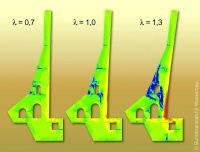Nonlinear structural engineering analysis (NiTrA)
From BAWiki

After approximately 40 years of operation a fatigue fracture was detected in the flexural tension reinforcement for the eastern chamber wall of the Bamberg lock (Main-Danube canal). Damages from material fatigue were also detected on other structures around the federal waterway. The BAW was asked to investigate the causes and report on its findings. Owing to the specific nature of material fatigue-related damages, the serious risks associated with them and their significance for other locks and hydraulic structures subject to cyclically recurring stresses, a comprehensive assessment needed to be undertaken of the structural safety of the locks along the Main-Danube canal and other federal waterways. The structural assessments are undertaken in the framework of a three-stage inspection programme, the last stage of which is a nonlinear system structural engineering analysis using the "NiTrA" system established for precisely this purpose.
Owing to the recurring revision of regulations since building work was completed, the formal application of current calculation standards using customary static models have proved insufficiently reliable. The reasons for this are the currently more demanding approaches to stress and impact combinations. The calculated load-bearing reserves arising from former static modelling, including cautious structural component resistances, are unable to compensate for these deficits. It is therefore important that the affected locks are statically modelled as realistically as possible. Realistically refers to a complex picture of the structure and ground, and the interactions between them. At the same time it is essential in a two-dimensional cross sectional consideration of the relevant lock chamber to take reasonable account of the geometry - bearing in mind its slab character (D areas) - as well as the material nonlinearities or the plastic behaviour of the reinforced concrete and the building ground.
Information about evidence of static load capacity based on nonlinear material behaviour and the requisite reliability format with the various reliability elements on the impact and resistance side are only dealt with briefly in the applicable standards. Basic requirements for reinforced concrete structures are stated in Section 8.5.1 of DIN 1045-1 (2008) or in the relevant section in the German Committee for Reinforced Concrete's (DAfStb) Book 525. These stipulations will be integrated in the national implementation document for the European Reinforced Concrete Code EC2.
DIN 1054 (2005) does not make any specific stipulations in the geotechnical field. It is only recently that recommendations have been elaborated in the context of work on Eurocode EC 7; however, these recommendations relate exclusively to geotechnical issues. There are still no satisfactory stipulations for a balanced reliability format for numerical studies of complex load-bearing systems consisting of building ground and reinforced concrete. In the framework of the stability studies on the reinforced concrete locks referred to above, a proof concept first needed to be drawn up and formulated which would guarantee a standardised, reproducible verification procedure at all locks and other solid hydraulic structures. This "concept for the static verification of the system load bearing capacity of locks on the basis of nonlinear material behaviour - NiTra" has already been successfully used several times and allows calculatory safety margins to be elicited and documented which the verification methods typically used in practical engineering are unable to provide.
back to: Structural Engineering Methods
